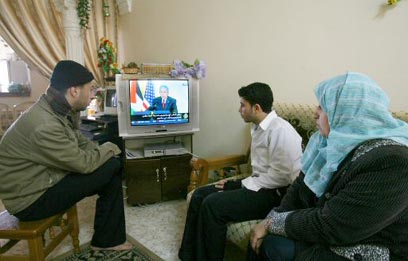
A numbers guide to PA
Statistics show Gaza Strip, West Bank are home to one of world's youngest populations. Palestinians prefer cell phones, almost every home has a TV, and internet access is becoming more popular
More than 4.048 million Palestinians reside in the West Bank and Gaza Strip. According to the Central Bureau of Statistics (CBS), in the past 13 years, their population has grown by over 45% - one of the highest population growth rates in the world.
CBS data suggests that that some 2.513 million Palestinians reside in the West Bank and east Jerusalem: Over 237,000 Arabs reside in east Jerusalem, 177,000 live in the West Bank city of Hebron, over 133,000 live in Nablus and some 30,000 Arabs reside in Ramallah, which is also home to the Palestinian Authority's formal institutions.
Official PA data suggests that the West Bank stretches across 2,183.4 square miles, and has population density of 433 people per square mile. About 37.3% of the West Bank's residents are under 14 years old and only 3.7% of them are over 65.
The population growth rate among the Palestinians stands at 2.2% a year, and the average marriage age is 20. A Palestinian woman gives birth to 3.12 children on average.
According to the CIA World Factbook, religious segmentation of the Palestinians living in the West Bank shows 75% of them are Muslims, 8% are Christians and 17% are of various religions.
Gaza style urbanism
Gaza Strip is home to 1.535 million Palestinians. Some 488,000 people leave in Gaza City, while 153,000 Palestinians live in the southern Gaza Strip town of Khan Younis, 135,000 reside in the northern Gaza neighborhood of Jabalya, some 132,000 live in Rafah and over 70,000 Palestinians live in the northern Gaza Strip town of Beit Lahiya.
Official data says that Gaza Strip spans across 139 square miles, and has population density of 4000 people per square mile – one of the highest in the world.
Some 72% off all Gazans reside in urban areas, and immigration rate in both the West Bank and Gaza Strip is virtually nil.

Switching on. The Gaza power plant (Photo: AP)
Gaza's population is among the youngest in the world, with 44.4% under 15 and only 2.6% over 65. According to the CIA, at 3.35% the Strip's population growth rate is the fifth highest in the world. The West Bank is ranked 44 and Israel is ranked 79.
The average marriage age in Gaza is 17.5 and the Strip in ranked 26th in the world for its annual birth rate – 37 newborns for every 1,000 people. The West Bank is ranked 68, and Israel is ranked 102nd.
The average Gazan woman gives birth to five children – setting the Hamas-controlled enclave at the 26 slot worldwide. The West Bank is ranked 65, while Israel comes in at the 83rd place.
Life expectancy in Gaza Strip stands at 70 for men and 72 for woman, placing Gaza at the 110th place worldwide and 20 slots ahead of the West Bank. Israel ranked a respectable 12th place.
According to the CIA, 99.3% of Gaza's residents are Muslims and only 0.7% of them are Christians. Some 92.4% are literate.
Socioeconomically speaking, Gaza has a 40% unemployment rate, a 70% poverty rate and 10% annual inflation.
The Strip is also the world's second-to-last power producer. Gaza produces only 65,000 kilowatts of electricity a year and gets the rest of its power from Israel and Egypt.
A TV for (nearly) everyone
The Central Intelligence Agency's factbook notes that the West Bank and Gaza Strip have about 360,000 landlines between them, and as many as 1.3 million cellular phones. Some 100 million phone calls, averaging three minutes, are made in the area every year; and some 356,000 Palestinian homes have internet access.
According to the Palestinian Central Bureau of Statistics, 97% of West Bank residents and 39.2% of those living in the Strip have television sets, and 20% and 5% (respectively) have DVD players.
Additional figures show that 8.4% of those living in the West Bank and 4.3% of those living in Gaza belong to a sports club, and 4.2% and 1.9% (respectively) have library memberships.

Connected. Watching TV in a Ramallah home (Photo: AFP)
Two percent of the Palestinians living in the West Bank and 2.2% of those living in Gaza are registered members of a political party.
Gaza Strip and the West Bank have 24 government-sponsored hospitals and 52 non-government medical facilities between them, amounting to 5,000 beds.
Financial activity
Trade and commerce figures suggest that in 2008, the Palestinian Authority exported $499 million worth of goods to Israel – nearly its entire export activity. Goods worth $46 million were exported to Arab nations and $13 million worth of goods were sold worldwide.
The Palestinians imported $3.5 billion million worth of goods in 2008: $2.8 billion's worth from Israel, $223 million's worth from the European Union and about $60 million worth of goods from the United States and Canada, making for a negative trade balance.
A strong economic sector of the Palestinian Authority is tourism: The Palestinians operate 100 hotels – 5,126 rooms and 11,301 beds – which hosted 452,625 visitors in 2003.

Palestinian PM Salam Fayyad during an olive harvest (Photo: AP)
Another economical staple in agriculture: some 584-sq. miles of the West Bank are designated farmland, as oppose to 42-sq. miles in the Gaza Strip. About 63% of the land is used for orchards and olive groves. In 2008, the PA produced 76,000 tons of olive oil – nearly double the production of 2007.
As for livestock, in 2008, Palestinian farmers grazed 688,000 sheep, 320,000 goats and 33,000 heads of cattle.
Red tape knows no bounds
The Palestinian Authority has over 466,000 buildings with over 700,000 housing units. Many of the Palestinians reside in private properties. Some 22.2% of apartments are five-room apartments or more, 32% are four-room apartments and 30% are three-room apartments.
The Palestinian courts are no strangers to red tape: Some 115,452 court cases were filed in 2006, joining 134,053 open cases. In 2009, Palestinian judges ruled on 101,000 cases and deferred the rest.
The majority of Palestinian prisoners in PA prisons are serving time for fraud, theft and drug-related offenses.
- Follow Ynetnews on Facebook










